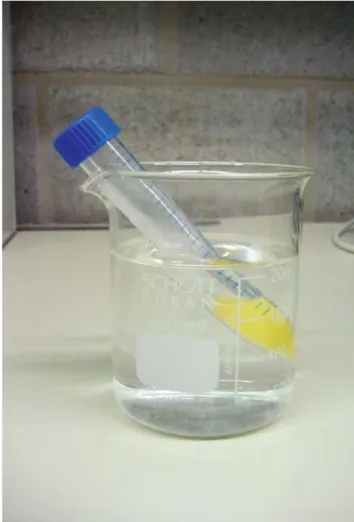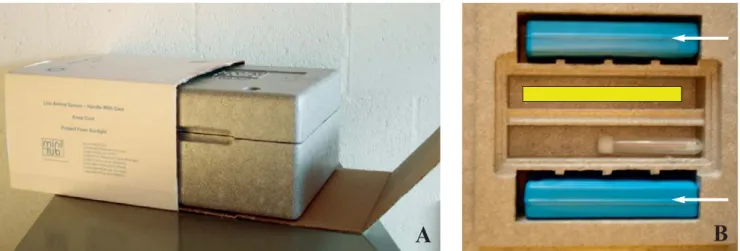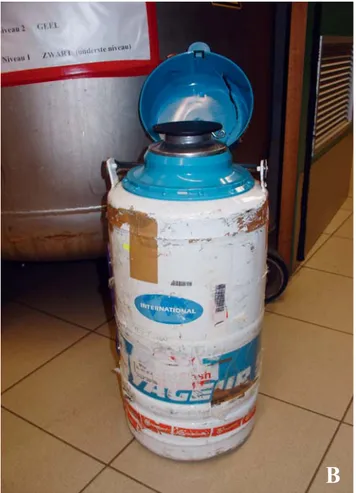248 Permanente vorming Vlaams Diergeneeskundig Tijdschrift, 2011, 80
INTRODUCTION
Artificial insemination (AI) in dogs can be perfor-med with fresh, chilled (4°C) or frozen-thawed (-196°C) semen. Artificial insemination with fresh semen was first described by the Italian priest Spallanzani in 1789. However, it was not until 1954 that the first successful AI using chilled (4°C) dog semen was reported by Harrop. Fifteen years later, Seager (1969) reported the first live offspring following AI with frozen-thawed (-196°C) canine semen. Because of the obvious advan-tages and possibilities, AI with chilled and frozen-thawed semen gained increasing interest amongst dog breeders, veterinarians and experimental research facilities worldwide. Chilled and frozen semen makes international transport of genetic mate-rial possible, as it is easier and cheaper than the trans-port of animals. Based on a large study performed in Sweden, the possibility for the international exchange of genetic material is the most important reason for performing AI in dogs (Linde-Forsberg and Forsberg, 1993). Moreover, AI with chilled and especially fro-zen-thawed semen makes it possible to valuable gene-tic material at a later time (even after the death of the dog) and has several economic and sanitary advanta-ges (Rijsselaere et al., 2001, 2010; Van Soom et al., 2001). Currently, in Europe, the percentages of canine AI’s performed by veterinarians using either fresh, chilled or frozen-thawed semen are 50-55%, 10% and 35-40%, respectively (Linde-Forsberg et al., 2010).
SPERM COLLECTION AND EVALUATION Dog sperm is generally collected by digital mani-pulation and stimulation of the bulbus penis (Linde-Forsberg, 1991). A quiet environment and the presence of a teaser bitch are advised for less experienced dogs. Alternatively, a vaginal swab of a bitch in oestrus which was collected previously and stored in the free-zer (-20°C), can be used to stimulate the male. In case of experienced stud dogs however, sperm collection is usually possible without any extra stimulation. The three fractions of the ejaculate are collected in sepa-rate, pre-warmed plastic vials. The first and the third fractions originate from the prostate (the only secon-dary gland in the dog); the second sperm-rich fraction usually consists of 0.5 to 5 ml sperm.
Immediately after collection, the sperm-rich frac-tion is evaluated macroscopically (volume, color, ad-mixtures and homogeneity) and microscopically (motility, concentration, morphology and membrane integrity) especially when the sample is to be chilled or frozen and transported. Motility (total and progressive) can be assessed subjectively on a pre-warmed glass slide on a scale from 0 to 100%. The sperm concen-tration can be determined using a counting chamber (e.g. Bürker or Thoma chamber) after a 1:40 dilution with tap water or diluted formol resulting in immobi-lity of the spermatozoa. The percentage of normal and membrane intact spermatozoa is generally examined on eosin-nigrosin stained smears by assessing at least 100 spermatozoa individually. The morphology can also be evaluated using a Diff-Quick staining. During
Preservation and shipment of chilled and cryopreserved dog semen
1T. Rijsselaere, 1D. Maes, 2F. Van den Berghe, 1A. Van Soom
1 Department of Reproduction, Obstetrics and Herd Health, Faculty of Veterinary Medicine, Ghent Uni-versity, Salisburylaan 133, B-9820 Merelbeke
2 Department of Clinical Sciences, Faculty of Veterinary Medicine, University of Liège, Boulevard de Colonster 20, B-4000 Liège
tom.rijsselaere@ugent.be
SUMMARY
The transport and artificial insemination of chilled (4°C) and cryopreserved (-196°C) dog semen have gained increasing interest worldwide and have become very popular among dog breeders. Whereas cryopreservation of dog sperm is a complicated and time consuming procedure, which is almost exclusively performed at universities, the chilling of dog semen can be handled by veterina-rians in their private practices, provided that the basic knowledge of chilling and diluting semen is acquired. Immediately after sperm collection, the quality of the fresh sample is evaluated and re-corded before diluting in an appropriate extender. Subsequently, the diluted semen is gradually chil-led to 4°C. It can be stored at 4°C for several days or transported in a thermos flask, a styrofoam box or a Minitübe neopore box. Cryopreserved dog sperm is mostly transported in a dry-shipper container. The rules and legislation for the shipment of chilled and frozen dog semen are rather complicated. They differ between almost every country and may change over time. To comply with all the administrative procedures, it is necessary to plan the transport of semen well in advance.
250 Vlaams Diergeneeskundig Tijdschrift, 2011, 80
the last decade, several new techniques for sperm as-sessment, such as computer assisted sperm analysis (CASA) and fluorescent staining techniques, have been described in dogs. They allow a more detailed and objective sperm assessment (Verstegen et al., 2002; Rijsselaere et al., 2005, 2007). A certificate with the results of the sperm evaluation immediately after collection should always accompany the sperm when transported. An example of a sperm certificate is shown in Figure 1.
SEMEN EXTENDERS
Since spermatozoa are metabolically relatively inert, the extracellular environment plays a crucial role in their survival. Prostatic fluid appeared not to be an appropriate medium for prolonged preservation of ca-nine spermatozoa at 4°C (England and Allen, 1992). Spermatozoa which are preserved either chilled (4°C) or frozen (-196°C) should therefore be diluted in a pro-per extender. Many different extenders have been des-cribed and are currently available. They have been proven to be suitable in both in vitro and in vivo stu-dies. In general, a semen extender should protect the spermatozoa from cold shock during cooling (by adding 10-20% egg yolk or skim milk), it should provide energy substrates (sugars such as fructose or glucose) and maintain the spermatozoa at a constant pH and os-molarity by adding buffers (England, 1993). To prevent the growth of bacteria, semen extenders should also contain some antibiotics (mostly penicillin or strepto-mycin). If the semen is frozen, cryoprotectants, such as glycerol, should be added. These extenders can be home-made by the veterinarian, they can be purchased at local universities or by several commercial compa-nies. In this respect, the Tris-citric acid-egg-yolk-fruc-tose based extenders (also referred to as the Uppsala diluents) are probably the most documented and used extenders for the preservation of dog sperm (Linde-Forsberg, 2002). Because egg yolk is a biologically ha-zardous compound, studies are performed replacing egg yolk by egg yolk derived phospholipids or vegetable le-cithin to avoid using substances of animal origin (Far-stad, 2009).
CHILLING SEMEN AND TRANSPORT
The use of chilled semen is especially interesting when the semen is to be transported over short distan-ces (within Europe) because it is easier and cheaper than using cryopreserved semen. A good follow-up of the bitch to determine ovulation and consequently to determine the ideal insemination days, is crucial be-cause it is better to inseminate the semen as quick as possible after collection. In general, semen can be de-livered in most of the European countries within 24 to 48 hours.
To chill a sperm sample, the second sperm-rich fraction can be diluted with Tris-citric acid-fructose di-luent with 20% egg yolk in a proportion of 1:3 to 1:4 (1 mL of semen with 3 to 4 mL of diluent).
Subse-Figure 2. A diluted dog sperm sample is placed in a water bowl (at 37°C) which can subsequently be placed in the fridge and slowly be cooled (in a ‘bain-marie’) to 4 or 5°C.
quently, the diluted sperm sample is placed in a water bowl (at 37°C) and slowly cooled (in a ‘bain-marie’) in the fridge to 4 or 5°C (Figure 2). The diluted semen can be stored at 4-5°C for up to 10 days, dependent on the type of extender used and the original semen lity. Some extenders can even preserve the sperm qua-lity in vitro for up to 27 days provided that the sperm diluents are refreshed every 10 days (Iguer-ouada and Verstegen, 2001).
Chilled semen can be transported in a thermos flask, a styrofoam box or a minitübe neopore box (Fi-gure 3A, 3B). In the past, a thermos flask and styro-foam box were frequently used but nowadays the minitübe neopore box is becoming more popular be-cause it is very practical, cheap and easy to use. Using this method, the extended semen sample is placed di-rectly into the box at room temperature and is cooled gradually by inserting 2 ice packs (stored at -20°C in the freezer) in the box during transport. The required temperature of 4-5°C is maintained for up to 48 hours (Linde-Forsberg, 2010). When receiving a chilled sperm sample, it is important to immediately assess the sperm quality to ensure that the transport was un-eventful. Chilled semen can be inseminated in the bitch either at 4°C or after warming the sample to 37°C (Rijsselaere et al., 2010).
FREEZING SEMEN AND TRANSPORT
The use of frozen dog sperm is especially indicated when transport over larger distances is required or when the genetic material of the stud dog will be used at a later time. The freezing of dog sperm is a rather complicated and time consuming procedure which is mostly performed at universities or large veterinary clinics. In Belgium, the kennel club Sint-Hubertus only allows dog sperm to be frozen in an official uni-versity centre (Faculty of Veterinary Medicine in Ghent or Liège) and only after approval of the stud dog by the kennel club.
Numerous procedures have been described for ca-nine cryopreservation with variable results. Our de-partment consistently uses the ‘Uppsala method’ with slight modifications (Linde-Forsberg 2001, 2010). In short, the second sperm-rich fraction is diluted with a Tris-citric acid-egg-yolk-fructose based extender with glycerol (3%) and chilled to 4-5°C for 1-2h (= equili-bration period). Subsequently, a second extender with Equex and a higher percentage of glycerol (7%) is added and the sperm is packaged in straws (0.5 or 0.25 ml) or in pellets. Both are considered to be equally good but 0.5 ml straws are more practical to handle and label. Straws should consistently be labelled with date, name of the dog, breed, tattoo or chip number and freezing centre. Finally, the straws are placed on a rack which is located several centimetres above the level of liquid nitrogen. By making variations in the distance of the sperm straws to the level of liquid ni-trogen, for variable periods of time, different freezing rates are created. The above mentioned freezing tech-nique is a ‘static method’, it is easy to conduct but al-lows only little control over the actual freezing rate. The repeatability of a freezing protocol can be impro-ved when programmable automated freezing devices (= dynamic method) are used, such as the Mini Digit-cool, the Planer 10 TM or IceCube (Sy-Lab) (Schafer-Somi et al., 2006), which may be useful when a large number of straws are frozen simultaneously (Figure 4). However, automated programmable freezers are
very expensive. Following the cryopreservation pro-cedure, the straws can be stored in a liquid nitrogen container (Figure 5A), if necessary for years until they are thawed and used for the insemination of a bitch or they can be transported abroad in a dry shipper (Figure 5B). The costs for the transport of dry-shippers are in general high due to the weight of the container (10-20 kg). Moreover, many airlines and transport companies are reluctant to ship them. Recently, a new single-use dry-shipper 3L (ST Technologies, USA) has been in-troduced. This shipper only weighs 4.5 kg when filled. It has a holding time of approximately four days and it is intended for a one-way shipment reducing the costs to about 1/4thcompared to normal dry shippers (Linde-Forsberg, 2010). Additionally, on some airlines, this new dry shipper is accepted as hand luggage (Linde-Forsberg, 2010).
Before inseminating the frozen semen, the straws should be thawed in a water bath at 37°C for 30 or 60 seconds or in a water bath at 70°C for 6-7 seconds. In Figure 3. Minitübe neopore box (A) for transport of chilled dog semen. Using this method, the extended semen (in yel-low) is placed directly into this box at room temperature and is cooled gradually by inserting two ice packs (white ar-rows) in the box during transport (B; blue ice packs).
Figure 4. Automated programmable computerized free-zer (Sylab) used at the department of Reproduction, Ob-stetrics and Herd Health, Faculty of Veterinary Medicine, Ghent University for cryopreservation of dog sperm.
252 Vlaams Diergeneeskundig Tijdschrift, 2011, 80
this respect, it is very important to consistently follow the thawing instructions of the freezing centre which should always accompany the shipment!
FREEZING OF CHILLED SEMEN
Several studies have shown that semen which was previously chilled for two to three days at 4°C, can subsequently be frozen successfully. This makes it possible to collect, to chill and transport the dog semen to a nearby semen bank where it can be cryopreserved and stored at -196°C for AI at a later time (Verstegen et al., 2005; Hermansson and Linde-Forsberg, 2006). REGULATIONS AND RECOMMENDATIONS FOR SHIPMENT
The rules for the shipment of chilled and frozen dog semen are rather complicated and differ from country to country. Some countries such as Belgium are ‘easy’ (category 1), while other countries such as Australia, are very strict regarding the import of dog semen (ca-tegory 4). Original import permits, a health certificate, several serological tests (for Brucella Canis and Lep-tospirosis) are only some of the requirements. The im-portation of chilled and cryopreserved dog semen into Belgium however, is currently not subject to any res-trictions, due to the lack of regulations. It should also be kept in mind that national legislation and regula-tions applied by the local kennel club may change in time. Moreover, the rules for importing chilled semen may be different from those applying to frozen semen. An excellent overview of the regulations and recom-mendations for shipment of chilled and frozen dog semen including many countries worldwide is publis-hed by Linde-Forsberg (2001) on the IVIS website (http://www.ivis.org/home.asp). It is therefore very im-portant to advise the importer or dog owner to contact the Ministry of Agriculture (or local authority) to in-form them about the current rules and regulations of a particular country. This should be done well in advance
of the planned sperm collection and transport in order to be able to carry out all the necessary blood tests, he-alth requirements and paper work.
CONCLUSION
The choice whether to use chilled or frozen dog semen for transport depends on many aspects, such as the distance (chilled semen is mostly used for trans-port within a country or within Europe whereas over-seas shipments are frequently performed using cryopreserved semen), the purpose of the semen (AI of only one bitch or AI of several bitches), the cost (cryopreserved sperm transport is often more expen-sive regarding the cryopreservation procedure and the shipping costs of the dry shippers), the local regula-tions (may differ for chilled or cryopreserved semen), the personal preference of the owner, the know-how and skills for inseminating chilled and frozen semen of the responsible veterinarian, etc. An overview with the different insemination techniques and the results which can be obtained following AI in dogs has re-cently been published by Rijsselaere et al. (2010). REFERENCES
England G.C.W., Allen W.E. (1992). Factors affecting the viability of canine spermatozoa. II. Effects of seminal plasma and blood. Theriogenology 37, 373-381.
England G.C.W. (1993). Cryopreservation of dog semen: a review. Journal of Reproduction and Fertility
Supple-ments 4, 243-255.
Figure 5. Liquid nitrogen containers used for long-term storage (A) and dry shipper used for international trans-port (B) of canine semen.
A
Farstad W. (2009). Cryopreservation of canine semen - New challenges. Reproduction in Domestic Animals 44, 336-341.
Harrop A.E. (1954). Artificial Insemination of a bitch with preserved semen. British Veterinary Journal 110, 424-425.
Hermansson U., Linde-Forsberg C. (2006). Freezing of sto-red, chilled dog sperm. Theriogenology 65, 584-593. Iguer-ouada M., Verstegen J.P. (2001). Long-term
preser-vation of chilled canine semen: effect of commercial and laboratory prepared extenders. Theriogenology 55, 671-684.
Linde-Forsberg C. (1991). Achieving canine pregnancy using frozen or chilled extended semen. Veterinary
Cli-nics of North America: Small Animal Practice 21,
467-485.
Linde-Forsberg C., Forsberg M. (1993). Results of 527 con-trolled artificial inseminations in dogs. Journal of
Repro-duction and Fertility Supplement 47, 313-323.
Linde-Forsberg L. (2001). Regulations and recommenda-tions for international shipment of chilled and frozen ca-nine semen. In: Concannon et al. (Editors). Recent Advances
in Small Animal Reproduction. International Veterinary
In-formation Service (www.ivis.org), Ithaca, New York. Linde-Forsberg C. (2010). Canine artificial insemination:
State of the Art. In: Proceedings 7th EVSSAR Congress, Louvain-La-Neuve, Belgium, p. 22-26.
Rijsselaere T., Van Soom A., Van Den Broeck W., de Kruif A. (2001). Kunstmatige inseminatie bij de hond. Vlaams
Diergeneeskundig Tijdschrift 70, 242-252.
Rijsselaere T., Van Soom A., Tanghe S., Coryn M., Maes D., de Kruif A. (2005). New techniques for the assess-ment of canine semen quality: A review. Theriogenology
64, 706-719.
Rijsselaere T., Maes D., Hoflack G., de Kruif A., Van Soom A. (2007). Effect of body weight, age and breeding history on canine sperm quality parameters measured by the Ha-milton-Thorne Analyser. Reproduction in Domestic
Ani-mals 42, 143-148.
Rijsselaere T., Van Soom A. (2010). Technieken voor kunst-matige inseminatie bij de hond. Vlaams Diergeneeskundig
Tijdschrift 79, 464-468.
Schäfer-Somi S., Kluger S., Knapp E., Klein D., Aurich C. (2006). Effects of semen extender and semen processing on motility and membrane integrity of frozen-thawed dog spermatozoa. Theriogenology 66, 173-182.
Seager S.W.J. (1969). Successful pregnancies utilizing fro-zen dog semen. AI Digest 17, 6-7.
Van Soom A., Rijsselaere T., Van Den Broeck W., de Kruif A. (2001). Het invriezen van sperma bij de hond. Vlaams
Diergeneeskundig Tijdschrift 70, 253-261.
Verstegen J, Iguer-ouada M, Onclin K, 2002: Computer as-sisted semen analyzers in andrology research and veteri-nary practice. Theriogenology 57, 149-179.
Verstegen J.P., Onclin K., Iguer-ouada M. (2005). Long-term motility and fertility conservation of chilled canine semen using egg yolk added Tris-glucose extender: in vitro and in vivo studies. Theriogenology 64, 720-733.


